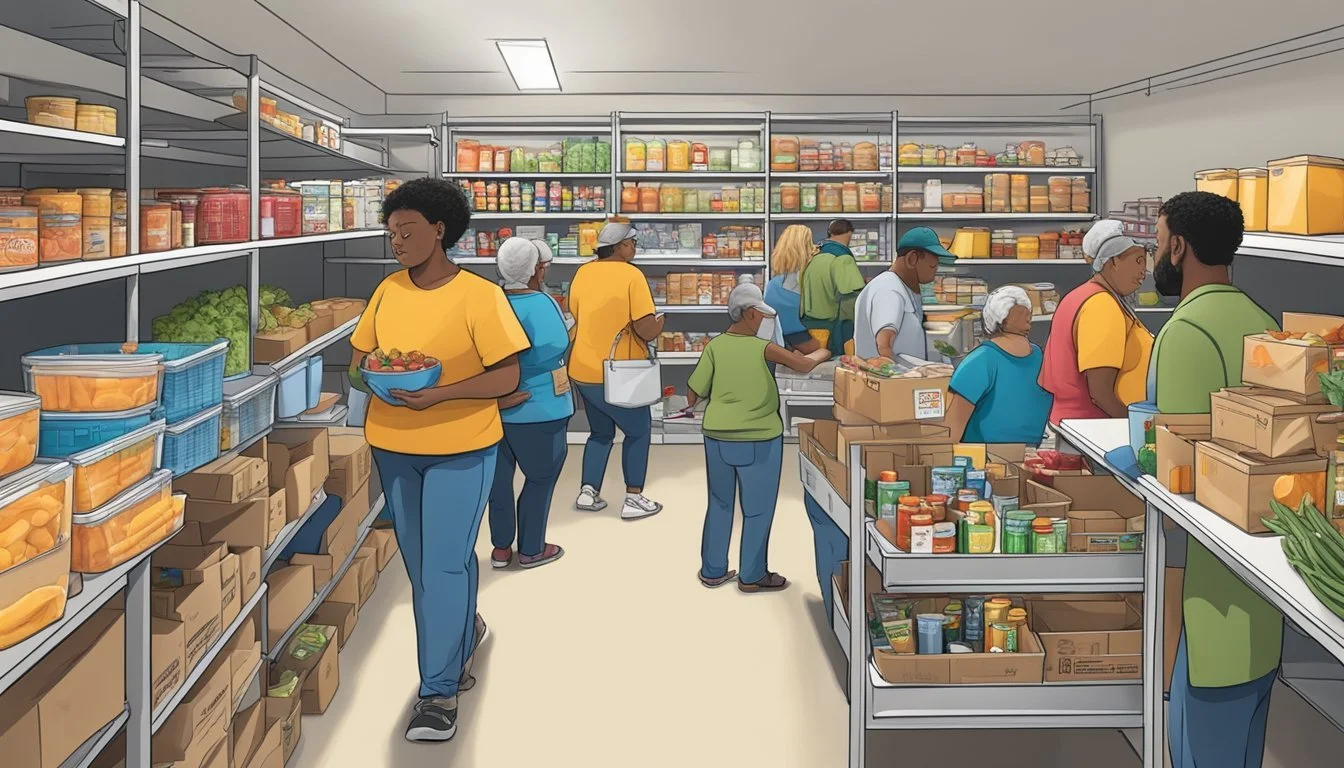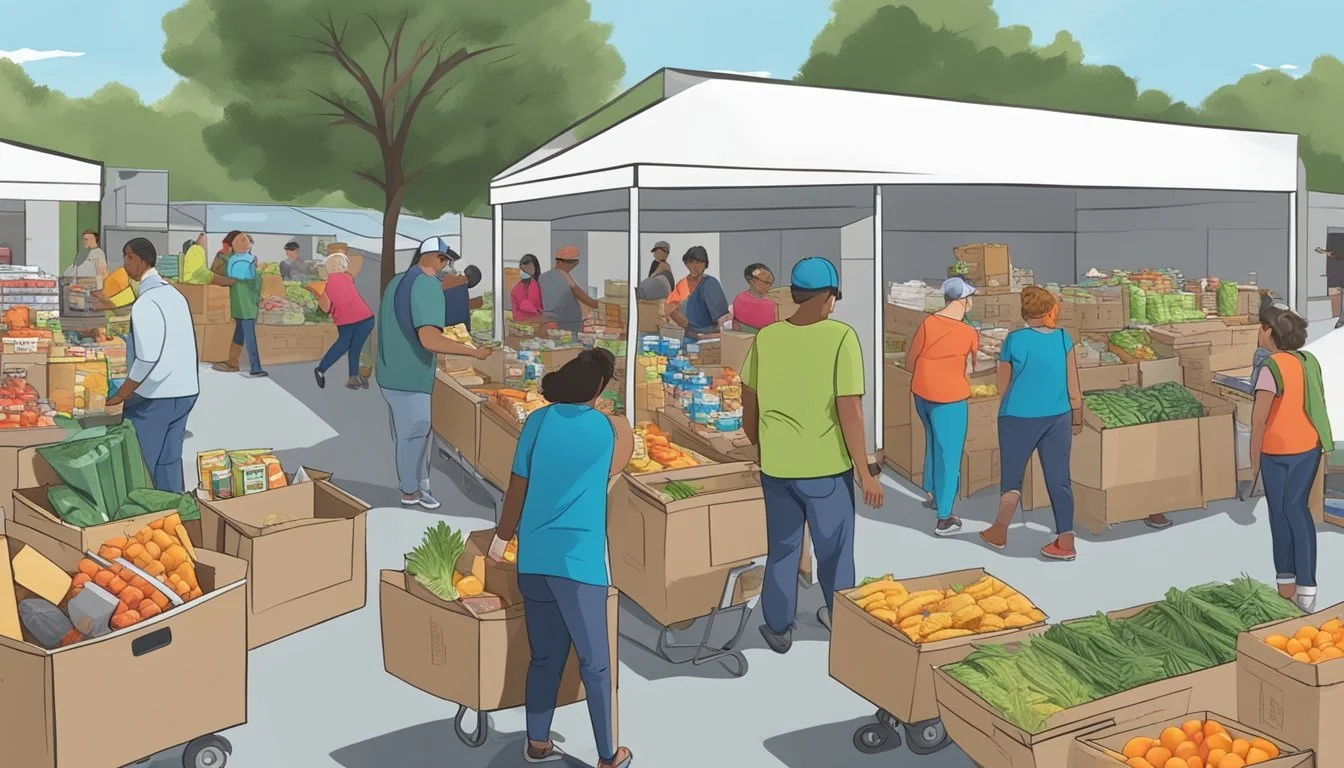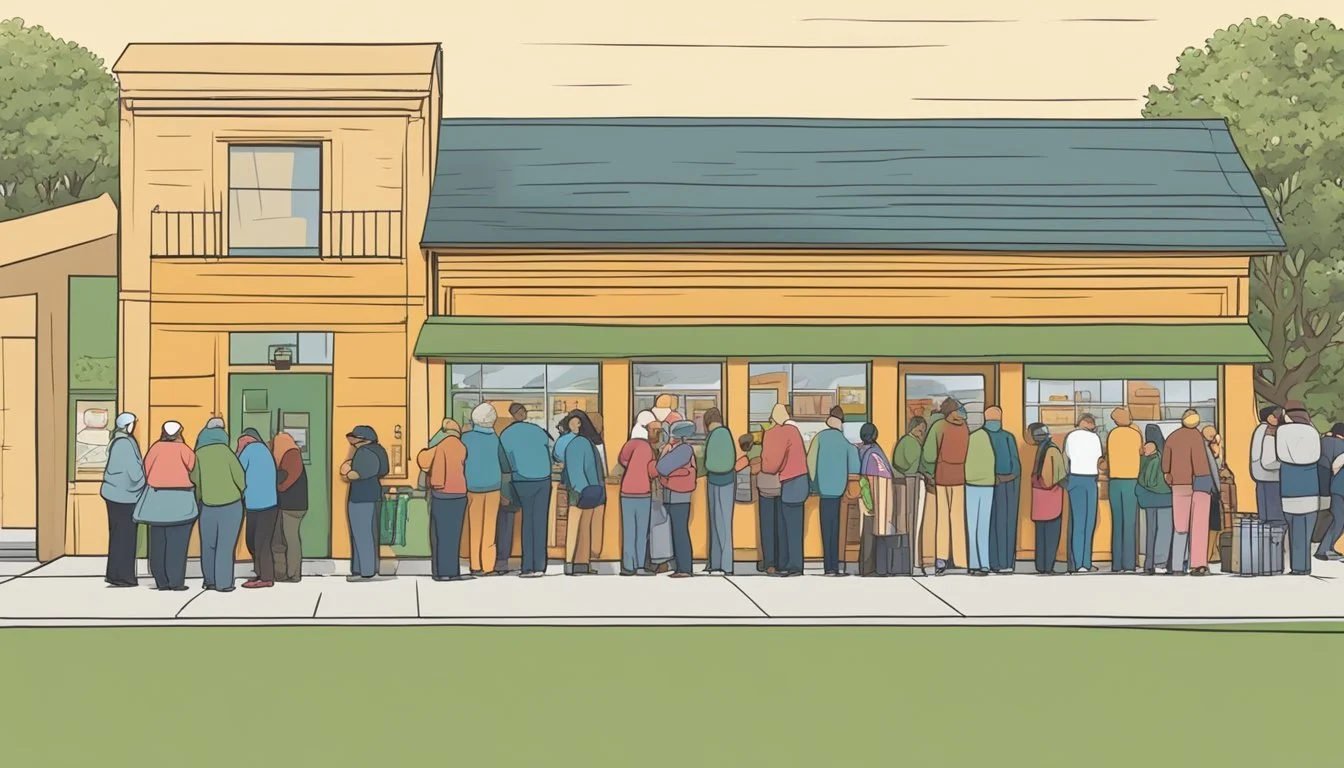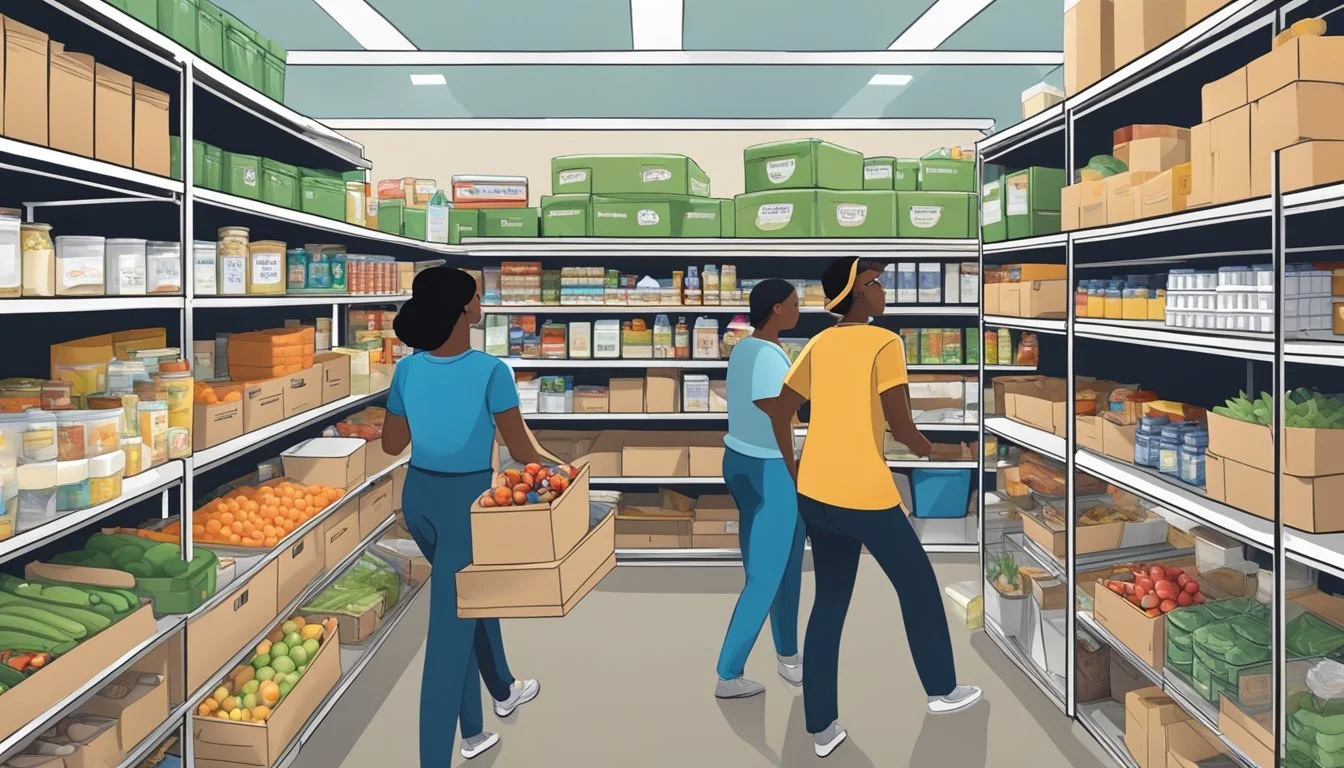Free Groceries and Food Pantries in Austin County, Texas
Your Essential Guide
This Article is Part of Our Guide on Free Groceries in Texas
Access to nutritious food is a vital component of a healthy community, yet food insecurity is a persistent challenge that affects many residents in Austin County, Texas. To combat hunger and provide assistance, a network of food banks and pantries offer free groceries to families and individuals in need. These food assistance programs are designed to bridge the gap for those facing tough times, ensuring that no one has to go without basic sustenance.
Food pantries in Austin County serve as pillars of support, with services tailored to the local community. They provide a range of items from shelf-stable foods and canned goods to fresh produce, dairy, and meat. These pantries not only meet immediate needs but also uphold the dignity of those they serve, fostering a sense of hope and community solidarity. Many operate under various organizations, including faith-based groups and non-profit agencies dedicated to eliminating hunger.
In addition to the traditional walk-in pantries, some innovative food assistance programs in the area include drive-through distributions and specialized services for certain demographics, such as older adults. These programs adapt to the community's needs and often involve partnerships with local businesses and national programs to maximize their reach and efficacy. Through continued community support, Austin County's food banks and pantries remain a crucial resource for those struggling to access nutritious food.
Understanding Food Insecurity in Austin County
In Austin County, food insecurity is a pressing issue that affects a diverse group of residents, undermining their access to nutritious food and impacting their overall well-being.
Defining Local Hunger Challenges
Food insecurity in Austin County is marked by the lack of consistent access to enough food for an active, healthy life. It's estimated that 14.7% of the county's residents have faced this uncertainty in 2021. Residents experience this acutely, with financial struggles and high living costs contributing to the challenge.
Impact on Families and Individuals
Economic disparities in Austin County have led to a substantial number of families unable to afford nutritious meals, with 177,300 individuals affected by food insecurity. This has a cascading effect on both physical and mental health. Seniors and children, often the most vulnerable to nutritional deficiencies, are particularly at risk.
Food Insecurity Among Children and Seniors
Children and seniors in Austin County face unique challenges when it comes to food insecurity. For children, lack of access to nutritious food can hinder physical growth and cognitive development. In seniors, it can exacerbate chronic health conditions. Food pantries and free grocery programs targeting these groups are critical for providing relief and support.
Local Food Banks and Pantries
In Austin County, Texas, residents have access to a robust network of food banks and pantries providing free groceries and support. These services are structured to alleviate food insecurity across various zip codes, with operational hours designed to cater to community needs.
Food Bank Overview
The Central Texas Food Bank is a key institution in the fight against hunger, serving as a hub for food collection and distribution. It operates in Austin, ensuring that individuals and families in need can access free and nutritious food. Individuals may connect with assistance programs like the Supplemental Nutrition Assistance Program (SNAP) through this food bank. Their network spans multiple locations, making it an accessible option for residents across Austin County.
Food Pantry Operational Insights
Food pantries within Austin County often have set schedules and unique operational hours to serve their communities. For instance, some pantries may operate specific days of the week, such as Monday and Thursday, ensuring that individuals can plan their visits accordingly. These pantries often post hours of operation and zip code-specific details on their websites for easy access to this information. Additionally, entities like Caritas of Austin and similar organizations offer listings of services that include not only food but also financial assistance for utilities and prescriptions, vital for a comprehensively supportive environment.
Programs and Services
In Austin County, Texas, a variety of programs and services aim to address food insecurity through both immediate and long-term approaches, serving the diverse needs of the community.
Emergency Food Assistance
The Central Texas Food Bank operates a home delivery program, partnering with local organizations to ensure free food is accessible in Travis and Williamson Counties, targeting those unable to visit food pantries in person. Various food banks and pantries such as the St. Elizabeth SVDP offer limited-hour services, including drive-thru pantries, to provide immediate relief to individuals and families in need.
Nutrition Education Initiatives
Nutrition education is a key component bolstered by various entities, aimed at empowering individuals with the knowledge to make healthier food choices. Programs may include hands-on culinary training programs, which not only teach cooking skills but also focus on utilizing nutritious ingredients to improve overall health.
Specialized Programs for Vulnerable Groups
Specialized programs recognize the unique needs of vulnerable populations such as children, seniors, and those with disabilities. These services ensure that tailored support, including appropriate meals and nutrition education, reaches those who may face additional barriers to food access. The Hope Food Pantry Austin, for example, extends its services to anyone in need, operating on specific days with hours clearly communicated to the community.
Getting Involved
Contributing time and resources to local food assistance programs is critical for sustaining and expanding the support these entities provide to the community. Individuals can engage through various roles, from hands-on volunteer efforts to monetary contributions and event hosting.
Volunteer Opportunities
Volunteer Roles:
Volunteer Ambassadors: They are the face of the pantry, offering a warm welcome and guidance to visitors.
Warehouse Assistants: Volunteers assist in organizing and managing food inventory.
Event Volunteers: They help run food drives and community fundraising events.
Transportation and Delivery:
Volunteers with vehicles are essential for transporting and delivering donations to the pantry.
Volunteer Commitment:
Offering regular time slots contributes to a consistent and reliable volunteer workforce.
Donating and Fundraising
Direct Donations:
Monetary contributions can be made online, providing immediate aid to pantries.
Shop to Give:
Partnered businesses donate a portion of proceeds from sales, allowing individuals to contribute while making everyday purchases.
Corporate Giving:
Companies can participate in matching gift programs, doubling the impact of individual donations.
Fundraiser Events:
Hosting or participating in fundraiser events raises significant funds and awareness for the cause.
By becoming a donor, volunteer, or advocate, community members aid food pantries like Hope Food Pantry Austin in their mission to combat food insecurity in Travis County.
Community Solutions and Partnerships
Community efforts in Austin County are marked by cooperative initiatives and novel programs that address food insecurity through collaborative partnerships and innovative strategies, ensuring access to food for those in need.
Collaboration with Local Partners
The Central Texas Food Bank stands out for its joint efforts with various entities, including the Austin Public Health Neighborhood Services Unit and Amazon. Together, they have launched a home delivery program, where enrolled participants receive a monthly box of shelf-stable groceries. This collaboration highlights the importance of partner agencies in extending the reach of food assistance services.
Innovative Community Programs
Initiatives like the Hope Food Pantry Austin underline the urgency of combating food insecurity, especially during the exacerbated conditions caused by the Covid-19 pandemic. Meanwhile, the City of Austin has taken strides towards addressing food deserts by planning a community-owned grocery project in East Austin. Furthermore, the GIFT Community Kitchen, managed by Good Work Austin, merges the concept of a nonprofit cafe with an educational dimension, serving the dual role of food provider and workforce development. In another innovative approach, Springs, a community-driven effort, provides free groceries to locals around-the-clock, sourced from surplus food to avoid waste.
Feeding America and Local Affiliation
In Austin County, Texas, the fight against hunger is strengthened by the national network of food banks under Feeding America, which serves as a unifying structure to support local communities. They operate by connecting individuals in need with free food assistance through various outlets, including food pantries, soup kitchens, and mobile pantries.
Feeding America’s network consists of over 200 member food banks that distribute a substantial amount of nourishment across the nation. This nonprofit organization plays a pivotal role in sourcing and distributing food to local affiliates that directly serve residents of Austin County.
Local entities collaborate with Feeding America to run programs like drive-thru pantries, which allow citizens to collect free, nutritious food without leaving their vehicles. This method addresses food insecurity while respecting the convenience and time constraints of beneficiaries. Listed below are some services facilitated by this collaboration:
Food Pantries: Local pantries provide a range of food items to those facing food insecurity.
Soup Kitchens: Prepared meals are offered for immediate consumption.
Mobile Pantries: For areas with limited access to permanent pantries, mobile pantries bring sustenance closer to those in need.
The following table outlines the community support via local Feeding America food banks and associated programs:
Service Type Description Notable Benefit Food Pantries Distribution of groceries for home preparation Customizable food selection Soup Kitchens Provision of ready-to-eat meals Nutritious meals with no preparation Mobile Pantries Temporary food access points Reaches underserved regions
Assistance in applying for SNAP benefits and locating federal programs that aid with food provision is also part of the support system. These efforts reflect the commitment to ensure that all community members in Austin County, particularly those in vulnerable situations, have consistent access to food.
Events and Food Distribution
Austin County provides an array of food distribution events and channels to assist those in need. Community events and resources are regularly organized to offer free groceries and support food security.
Upcoming Local Events
Hope Food Pantry Austin often hosts events to distribute free groceries, alleviating food insecurity within the county. They successfully distributed the equivalent of over 172,000 meals in 2022.
Event: ACC Riverside Campus Initiative
Description: Collaborative effort with the City of Austin and Central Texas Food Bank, offering market-style food distribution.
Date: Please check the ACC website for upcoming dates.
Austin's El Buen Samaritano and local churches also routinely schedule food pantries and feeding events, precisely detailed on their respective websites or community bulletins for accessibility.
Food Distribution Channels
There are several dedicated channels through which residents of Austin County can obtain free food.
St. Elizabeth SVDP: Offers limited pantry hours with a drive-thru option in Austin, ensuring convenience for individuals with transportation.
Contact: 512-251-9838
Location: 1520 Railroad Ave., Pflugerville, Texas
Central Texas Food Bank: Provides a comprehensive list of pantry times and a Mobile Pantry Calendar, which are crucial resources for those seeking food assistance.
Resources: Referral Guides in English and Spanish
Services: Mobile pantry information readily available online
El Buen Samaritano stands out for its emergency food pantry, supporting families facing financial constraints with necessary food supplies and essentials like baby supplies and personal hygiene products.
Aid Beyond Food
In Austin County, Texas, residents in need can access various support systems that extend well beyond immediate food assistance. These services are designed to provide a more comprehensive safety net, addressing financial stability, housing security, educational opportunities, and employment training.
Financial and Housing Assistance
Austin County offers a range of financial and housing assistance programs aimed at ensuring residents have the support they need to maintain stability. Social services agencies provide:
Emergency Rent and Utility Assistance: Short-term help to prevent homelessness.
Long-term Housing Support: Programs that assist with locating and funding stable living arrangements.
Educational and Job Training
Beyond basic needs, Austin County is committed to the advancement of education and job skills. These services include:
Educational Programs: Initiatives to enhance literacy and offer GED completion opportunities.
Vocational Training: Courses and workshops targeting specific job skills that align with current market demands.
These subsections operate as critical components of the county's strategy to not only "find food now" but also to ensure sustainable income and employment for all residents, sowing the seeds for long-term economic independence.
How to Find Help
Individuals and families in Austin County, Texas seeking assistance with food necessities have access to a variety of resources. These include tools for locating food pantries and assistance programs for obtaining food stamps.
Using the Find Food Now Tool
To locate nearby food pantries Find Food Now, a tool provided by local organizations, can be used. Simply enter a zip code on the tool's webpage, and it will display a list of food resources in the area. This tool is essential for families, seniors, and anyone in need of immediate food assistance.
Example:
Zip Code: 78745
Resource Found: Bread for All Food Pantry, 1314 E. Oltorf Street
Assistance with Food Stamps
For long-term support, Austin County residents may apply for food stamps, now known as the Supplemental Nutrition Assistance Program (SNAP). The application process can be initiated online, over the phone, or in person at a local benefits office. Residents may also contact local food pantries for guidance on the application process.
How to Apply:
Online: Texas Benefits Website
Phone: Call 2-1-1 for assistance
In Person: Visit the nearest Texas Health and Human Services office
Both services aim to ensure that children, adults, and seniors have access to the nutrition they need.
Organization Insights
In Austin County, Texas, several organizations demonstrate a strong commitment to addressing food insecurity through free grocery distribution and food pantry services.
About the Food Bank
The Central Texas Food Bank stands out as a pivotal institution in the fight against hunger. It has a comprehensive approach to providing food security to individuals and families in need. The food bank's history reflects a deep-rooted intention to serve the Austin community, marked by growth and an expanding reach to those facing food scarcity.
Leadership Team: Guided by a knowledgeable leadership team, the organization ensures that its operations align with its mission to nourish hungry people and lead the community in ending hunger.
Board of Directors: The Board of Directors oversees the strategic direction of the food bank.
Press Releases and Newsletter: Regular press releases and a newsletter keep the public informed on the organization's latest developments and initiatives.
Financials are transparent, with detailed reports available to the public to ensure accountability and trust.
Operational Transparency
Operational transparency is a core value among Austin's food assistance organizations. By providing clear insights into their workings, these organizations maintain public trust and foster community engagement.
Feedback: They actively seek community feedback to understand the impact of their services and areas for improvement.
Financials: Annual financial reports highlight the stewardship of donations and effectiveness in food distribution.
About Us: An 'About Us' section on their websites offers comprehensive information about the mission, vision, and impact of these organizations.
Entities like the Hope Food Pantry Austin stand as examples of operational transparency, making clear their status, their response to crises like Covid-19, and the significant food insecurity rates they aim to combat in Travis County.
Tables to show example financial transparency (hypothetical figures):
Year Revenue Expenses Net Income 2022 $5M $4.5M $500K 2023 $5.5M $5M $500K
In conclusion, these organizations provide essential services to the community, doing so with a clear and open approach that encourages trust and continued support.
Resource Connection
In Austin County, Texas, individuals in need can access essential assistance through a network of agencies and resource centers, which are bolstered by contributions from the food industry and organized efforts to educate and report on food security.
Agencies and Resource Center
Agencies operating within Austin County provide comprehensive services to the community. Food pantries, such as Hope Food Pantry Austin and St. Elizabeth SVDP, are vital resources, ensuring that grocery items are readily available to those facing food insecurity. These pantries often benefit from food industry donations, with many local businesses regularly contributing surplus goods to help stock the shelves. Furthermore, resource centers serve as hubs for connecting individuals to various support services, including access to free groceries.
St. Elizabeth SVDP Food Pantry
Address: 1520 Railroad Ave., Pflugerville, Texas 78660
Contact: (512) 251-9838
Services: Food pantry assistance
Educational Materials and Reporting
Educational materials are distributed by resource centers and agencies to inform the community about nutrition and the services available. Reporting tools, such as a service insights portal, offer agencies the information needed to improve and expand their offerings. This includes the ability to track food industry donations and the efficiency of distribution networks. Additionally, agencies may convene at an agency conference to share strategies and best practices, ensuring a cooperative approach to addressing hunger and food scarcity.
Reporting and Education Highlights
Service Insights Portal: Enables data-driven decision-making.
Agency Conference: Facilitates the exchange of innovative solutions.
Logistics and Infrastructure
Effective logistics and infrastructure are pivotal for offering free groceries and food support services in Austin County. The section covers crucial components like the food hub system and warehouse and transportation management, which are integral to the functionality and reach of these services.
The Food Hub System
In Austin County, the food hub system functions as a centralized network, where various food pantries like Hope Food Pantry Austin collaborate to streamline the distribution of food. Food hubs aggregate, distribute, and market food products from local producers, facilitating a steady flow of groceries to those in need. This system not only supports the local economy but also assures that fresh produce reaches individuals and families efficiently.
Features of Austin County's Food Hub System:
Aggregation: Combining foodstuffs from multiple sources to ensure variety and volume.
Marketing: Partnering with entities such as merch stores to increase visibility and community engagement.
Distribution: Ensuring that a range of pantries, including drive-thru options, reliably receive supplies.
Warehouse and Transportation Management
The warehouses in Austin County perform critical roles in the food assistance network, acting as the primary storage for the collected and donated goods until they are distributed to the pantries and programs. Efficient warehouse management ensures that food products are stored safely and are easily accessible for distribution.
Key Aspects of Warehouse Management:
Proper storage conditions to prevent spoilage and waste.
Inventory systems to track food supplies and anticipate needs.
Transportation management is equally vital, involving a network of vehicles and logistics personnel who deliver foodstuffs to distribution points across the county. This system ensures that free food banks like St. Elizabeth SVDP and social services programs remain stocked.
Transportation Management Essential Elements:
Reliable fleet of vehicles for timely and effective food deliveries.
Route planning to minimize delays and maximize delivery efficiency.
Contact and Support
Those seeking assistance or interested in supporting the efforts of food pantries in Austin County can easily reach out for more information or engage through various opportunities. The organizations pride themselves on their accessibility and welcome involvement from the community.
How to Reach Us
For individuals seeking assistance with food insecurity, contacting the relevant food pantry is the first step. Hope Food Pantry Austin, for instance, can be reached at 512-251-9838. One can also find information on their website regarding operational hours and service details. For broader assistance and information about federal food assistance programs, such as SNAP, Feeding America provides valuable guidance.
Career Opportunities and Volunteering
Food pantries and related organizations often have openings for various roles that support their mission. To explore career opportunities, interested individuals should visit the respective websites, where they can usually find a 'Careers' section. Alternatively, for those willing to volunteer, reaching out through a 'Contact Us' form on the organization's website or a phone call can be the initial step. Volunteering positions range from food sorting to administrative help.
Note: The listed contact information and opportunities are subject to change, and one should verify the details with the respective organization.










